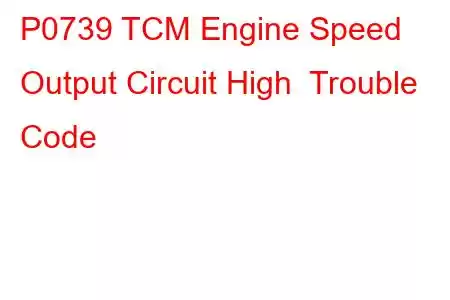P0739 TCM Engine Speed Output Circuit High
OBD-II Trouble Code Technical Description
TCM Engine Speed Output Circuit High
What does that mean?
This is a generic powertrain diagnostic trouble code (DTC) and applies to OBD-II vehicles. That may include but is not limited to vehicles from Dodge, Chevrolet, Honda, Toyota, Hyundai, Jaguar, etc. Although generic, the exact repair steps may vary depending on year, make, model and powertrain configuration.
The TCM (Transmission Control Module) works similarly to the ECM (Engine Control Module) in that, it monitors, controls and regulates the functions of the transmission where the ECM does the same for the engine.
The TCM uses various sensors and switches as well as the ECM to monitor, control and regulate the drivability of the transmission. In particular, The TCM uses an Engine Speed Sensor (ESS) to determine shift points among other functions. Just like the name implies, the ESS monitors the speed of the engine. Other names for the ESS may be CKP (Crankshaft Position Sensor) or OSS (Output Speed Sensor).
Most times, it measures the speed of the crankshaft using a hall effect type sensor. The sensor uses notches in the flywheel that pass through the sensor to monitor the position of the crankshaft. It is imperative that the ECM and TCM have an accurate reading here as it influences among other things: Shift points, Speed, Driveability etc.
The ECM activates P0739 and associated codes when it monitors one or multiple conditions outside a specific electrical range within the Engine Speed Sensor or it's circuit. Given the nature of the code and the location of the sensor, i would say most times this would be an electrical issue. Specific mechanical issues may cause this code but i would say they are somewhat rare.
P0739 TCM Engine Speed Output Circuit High code is set when the ECM monitors a higher than desired specific electrical value within the Engine Speed output circuit(s).
What is the severity of this DTC?
I would say severity here would be low. Obviously, this depends on the specific situation but in general, this fault will only cause drivability issues. That being said, prolonged use with this fault may cost you in the long run so make sure to keep an eye on it.
Photo of a transmission control module:
What are some of the symptoms of the code?
Symptoms of a P0739 trouble code may include:
Hard shift Fuel mileage drop No start Low speed Engine stalling/bucking Inaccurate speedometer Less throttle responseWhat are some of the common causes of the code?
Causes for this P0739 transmission code may include:
Defective Engine Speed Sensor (ESS) Defective ECM (Engine Control Module) Defective TCM (Transmission Control Module) Wiring issue Dirty pickup on the ESS Connector problemWhat are some P0739 troubleshooting steps?
Be sure to check for technical service bulletins (TSBs) for your vehicle. Getting access to a known fix can save you time and money during diagnosis.
Tools
Some of the things you may need when diagnosing or repairing engine speed output circuits and systems:
OBD code reader Multimeter Basic socket set Basic ratchet and wrench sets Basic screwdriver set Battery terminal cleaner Service manualSafety Tips
Let engine cool Chalk wheels Wear PPE (Personal protective equipment)NOTE: ALWAYS verify and record the integrity of your battery and charging system before further troubleshooting.
Basic Step #1
If your car's engine cranks fine but does not start, it may indicate a problem within the ESS (Engine Speed Sensor) itself. Test the sensor using desired electrical values from the manufacturer. Repair or replace accordingly. Typically speaking, these sensors read the speed of the crankshaft so it would most likely be mounted somewhere on the engine block.
Read: 30


